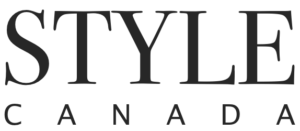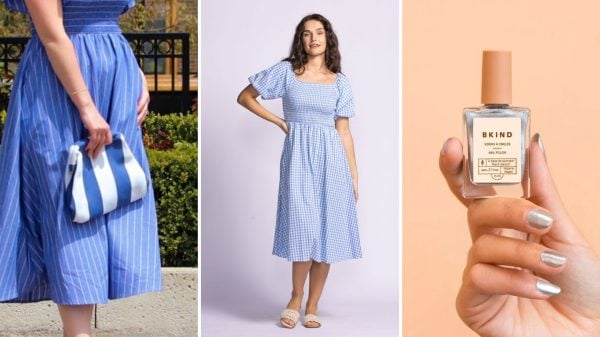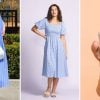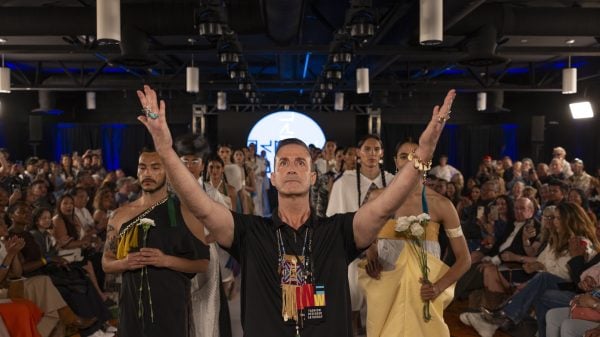On this week’s Let’s Talk About… episode, Elise sits down with Cassandra Burrell, Founder of Cassandra Elizabeth.
Cassandra Elizabeth is a clothing line that provides sustainable and genderless clothing with the goal of making the fashion industry more transparent and inclusive. Along with their products, they also offer services like Style Consulting, Closet Edits, and Personal Shopping to help you find a style that suits you.
Elise and Cassandra talk about the story behind Cassandra Elizabeth, sustainability and genderless fashion, and the importance of transparency and inclusivity in the fashion industry
“And so there’s this middle ground that I love. This is where I live, you know, in that middle ground of you can dress it up and you can dress it down. And that’s where we’re at. And that also aids in slow fashion and having your items, you know, getting cost per wear because you are wearing them all the time.” Cassandra tells Elise on Let’s Talk About.
To listen to this episode of Let’s Talk About, simply click here or search for “Let’s Talk About by STYLE Canada” on any major streaming platform.
Check out Cassandra’s products at our ‘the edit’ summer pop-up in Niagara-on-the-Lake. Our chic general store located at 1-233 King Street in NOTL, is open everything Thursday to Monday from 10:00 a.m. to 5:00 p.m.
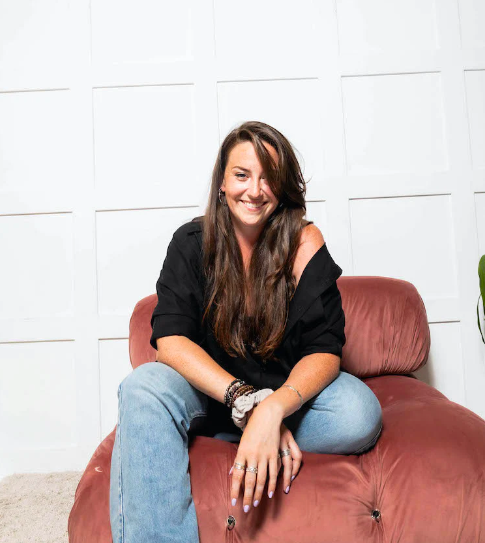
Check out the show transcript below.
[00:00:00] Elise: Hi everyone. And welcome this week. We’re talking to Cassandra Elizabeth founder, Cassandra Burrell. Hi, Cassandra. Thanks so much for being here with us today.
[00:00:09] Cassandra: I know, so excited. Thank you.
[00:00:11] Elise: Yeah. I mean, we know each other, I know your story excited that you’re gonna share it with the audience as well and excited to have you be a part of our popup in Niagara-on-the-Lake for the month of August, which is very exciting and your line has been doing really well as well, so exciting to kinda get the backstory of the line now for everyone listening.
[00:00:36] Cassandra: Yeah. Yeah, that sounds good. I know. I’m so excited about the popup. Honestly. I just need to say that Niagara needed this so I’m pumped that it’s there and doing so well. Yeah.
[00:00:48] Elise: So I was just sharing with Cassandra before we started recording that we sold two of our items yesterday and what I didn’t share was that they were two locals that came in and just literally wanted to support the shop loved what it was like, loved the look, love the feel, love, love the concept of it. So yes, agreed in that. It feels very needed in the area. So excited to, to be there for the month of August too. And then we’ll see what beyond looks like.
[00:01:16] Cassandra: Yeah. That’s awesome. That’s good.
[00:01:17] Elise: Yeah. So why don’t you start us off at cause again, I know a lot of your journey, you’ve been kind enough to be a part of different things that I’ve done in the past too, but I’d love for you to share kind of where you got started. And then we can get into a little bit about the brand story as well.
[00:01:34] Cassandra: Yeah, for sure. So me personally, I have always been on the kind of designer train, like I used to make dresses, for women. basically like people that went to university with me that had galas and stuff to go to, and I loved sewing. So I did go to school for fashion design, but it was more like hands-on. It was good, you know, five people in our class, very targeted to these people are going to construct garments. It was not like at all on the business side. So very much for, I wanna be a fashion designer, which was really cool. And I think gave me a lot of insight into really the time and energy that it takes to make a garment and, you know, the behind-the-scenes part of it versus just the business side of starting a business. Mm-hmm that was really important because moving forward, when I stopped sewing everything, myself and I started hiring people to sew it. I was looking for people like myself. Like I was hiring home sewers. I didn’t even know about manufacturers to be honest. And mm-hmm I was just hiring people who genuinely enjoyed and then when I did start learning about manufacturers, I was instantly saddened by the whole. The whole industry and would start exploring them in Canada. You know, there’s even ones that are questionable around Canada. um, sure. So it was just like a rabbit hole of information of how people are treated that make garments. And it led to the very sustainably, ethically made clothing line that I have now. it’s always. The same journey that I’ve been on, but I’ve just switched directions a little bit from, you know, not really caring about what fabrics I’m using and who’s making it. Cause I didn’t have the information to really caring about, The sustainable, responsible, ethical side of, of the business. And, it moved from women’s wear to genderless and that also just aids in the sustainable fashion. So yeah, that’s where I am now.
[00:03:36] Elise: I think that the interesting thing about your story, and maybe you can give some timelines to things is that you were doing sustainable and genderless. I wanna, I’m pretty sure before, like, The norms were, I guess, or the, the masses were. So what did, what was that timeline of? Like when did you go to school? What, like, what was the sequence of those events?
[00:03:58] Cassandra: Yeah, so I went to school in 2008. Um, I was doing very much just like whatever fabric I could get my hands on. Whatever women’s gala looks, um, around 2012, I’d say I started using more like sustainable fabrics, but not understanding why I was using them. Okay. I’d say 2014 is when I really started like educating myself on sustainability and who’s making the clothing, um, how people are treated, that kind of thing. And the reason why I use natural fiber is, is cuz they genuinely lasted longer. So I was making myself dresses for friends that would wear them and it would rip after as a couple wears. And I thought it’s not ripping in the seam where I sewed it. It’s ripping in the fabric. Like, so that’s kind of, you know, not the best quality fabric. So I fan when I would use things like bamboo was my first ever fabric that I,
[00:04:51] Elise: And you still use a lot of bamboo too, right?
[00:04:53] Cassandra: Yeah. Exact same fabric from the same supplier that I used in 2014. That’s great. Um, So when I started using those fibers, people had them for so much. Like I still have my items that I made in that I sewed myself in 2014.
So I think, oh, that’s
[00:05:09] Elise: That’s amazing. Oh my gosh, you’re going on a decade with those pieces,
[00:05:13] Cassandra: Right? Yeah. Wow. I think that like really says a lot about. The natural fibers. And that’s what led me to the sustainability side in those. Um, and then with having home sewers and manufacturers and all that stuff was around the same time, 2014. That was just very like touching to me because I’ve sewed a lot. Mm-hmm so that led there. The genderless thing came after. I educated myself a lot on sustainability. I find it was almost impossible to find a women’s OPEG T. So I just, all of them were see through, especially white, like a white t-shirt for women. Yeah. And so, so I was like, what is this? So I tried to make one and, um, I would personally go shopping for the men’s t-shirts and buy them all the time for myself. So. I took it as like a little challenge one day to make something that would fit both men and women. And try and close that gap of like, there is no women’s plane cotton. Mm-hmm like, I dunno, it was weird. This was like 20 14, 20 15. Anyway. Mm-hmm um, so by 2016 I had made a genderless clothing line. People hated it.
[00:06:19] Elise: I was gonna ask like, yeah, because I think we’re talking present day and we’re like, yeah, of course. But like 2014 sustainability, 2016 genderless, like that was six years ago. Am I doing my math? Right. And that’s not, it wasn’t like the norm and I don’t even think it’s totally the norm now, but like, Yeah. Tell us a little bit about what the reaction was.
[00:06:40] Cassandra: It was crazy. So first of all, the sustainability thing, all everyone came in. I had a little shop in Halifax in 2014 and I. Try and educate. Now, I’ll only let people know if they ask about it, but I would try and educate about sustainability. And I got granola was the number one descriptor of my brand, some new granola linen. I wasn’t, I didn’t use linen until this year. This is my first, like some granola linen, flax brand. Opened in Halifax. And I was like, like, they literally pictured me running through a grass of, or a field of wheat. You know what I mean?
[00:07:20] Elise: Like a flower crown.
[00:07:22] Cassandra: Yeah. So granola was the descriptor of the next three years of my brand. Um, and then when I did genderless, I got a lot of backlash, like, Ugh, it’s unisex. Like we’ve had unisex, unisex is over, you know, and I’m like, yeah, it. UN sex it’s genderless. Like it’s, you know, we’ve, we’ve upgraded our, our wording, but yeah, it’s, it’s the same. And we have had it mm-hmm so what’s wrong with that? I’m just continuing it, everyone hated it. They just thought like, you know, men’s bodies are different than women’s bodies and whatever. Um, it’s never gonna fit the same. And I was like, well, that’s the challenge for me is that I have to figure out a way to make it look good on both men and women and absolutely. None of my stuff is tailored for a reason that you’re, you’re correct. And thinking, you know, like men’s shoulders are wider and women’s hips can be wider. Um, everyone’s body is different. It’s hard to get anything tailored, no matter you’re still gonna have an issue, finding something that’s tailored to fit you. Mm-hmm so it’s another reason why a lot of my pieces are so oversized or looser and. Yeah. So people really didn’t grasp that concept. It even continued, um, once 2018 hit, I had the brand that I have now. Um, so it was very much like sustainable genderless. This is the collection and I added in like a seasonless element. So I, I then wanted to make things that you could have year round. So none of my clothing, you know, comes really winter in the winter and then really summer in the summer. Layer it up when it’s colder and on its own when it’s, um, cooler. And then that helps people feel as though they don’t need to throw out clothing in a season. Yeah. You know, so more, more sustainable that way.
[00:09:07] Elise: Yeah. Which is funny, cause I feel like all the major, like I’m thinking luxury fashion brands anyway, like now. Men and women walk down the runway and the same things now are like questioning what seasonality looks like. Right. And the sales cycle and all that. So like, it’s, it’s interesting. How ahead of that you were, which begs the question? What do you think’s next?
[00:09:30] Cassandra: I know
[00:09:31] Elise: No pressure.
[00:09:33] Cassandra: Oh my God. I honestly. Was it even like I was sitting there thinking, Ooh, genderless clothing, that’s gonna be trendy.
[00:09:38] Cassandra: I never thought that for a second. You know, mm-hmm um, or seasonless. I just thought like all of these things aid in, in, um, slow fashion, but my vision. My overall vision and all of these things play into it for the future. And I would love if everyone jumped on board, this, um, is that, you know, when you walk into a store, you just go shopping for clothing.
[00:09:59] Cassandra: And like, that’s what it is. There shouldn’t be any description of, you know, what do you sell in here? Whatever, if you like it, you buy it. And that’s kind of my hope for the future. Mm-hmm right now, what you have is segregated men’s women’s um, teenager 30 year old. 70 plus sustainable non-sustainable, you know, it’s just all over the place. Mm-hmm and what I would love to happen, even for these big box stores, you know, I want them to go away, but if they are sticking around, they are jumping on the genderless train. It would be so beautiful to just walk into a store and then. Not have to feel uncomfortable or like wonder who is this made for it? And just pick up a t-shirt and if you like it, you buy it. If you like it, you like it. Yeah.
[00:10:43] Elise: Yeah. Oh, I love that vision for the future. yeah. You’re you’re making it all sound like fairly seamless. But obviously I’m sure it wasn’t. And you mentioned your store in Halifax. I know you’ve had some other retail locations. What were some of like the challenges on this journey? Like what were your top, top two to three challenges that you sort of faced in getting to where you are today?
[00:11:06] Cassandra: Um, okay. I think the biggest one is that I did it completely backwards of what would be typical. So normally I guess I like doing that in all aspects. but normally what would happen. Or at least I’ve found in my experience is that people would, start with, you know, an online store and then do little popups here and there, like the one that’s happening with you in Niagara. Do some wholesale maybe. And then once they’re really established open a store, So, what I did is before I even had a website, I opened a store it, it was no like not a long commitment and it was in Halifax, Nova Scotia, which is great. So, and I’m from there. So I had like a lot of support anyway. So I, I went the store route and then I figured it out as I went along. If I could go. I think I would start the online route first. I didn’t realize how many steps there were involved, like, um, of building an audience, like a, a clientele, reliable clientele. This has been, this is my fifth year as like a corporation, like registered business. And I think now I can see. Like how the wheels are turning and that I maybe could have done this 10 years ago, but that’s okay. That was number one. Number two, I think is hiring people. I think it’s really important to hire people who are better than you are at what you’re hiring them for. So mm-hmm, what I typical. Do because I’ve had, um, a lot of students come to me asking if they, if I had internships and stuff and I wanna help everyone, like I really do wanna help. But what was happening is I would hire someone that I would then have to teach and like train and whatever, and that’s good, but I’m still building a business like this is a startup. What I needed to do and what I’m doing going forward is, you know, if I need help with marketing, I need to hire someone who’s knows more about it and can teach me than I can teach them. You know what I mean? So
[00:13:11] Elise: that’s a great lesson I feel like is even registering with me a little bit. Yeah. Um, because yeah, you it’s like wanting to give opportunities, but then also there’s only cuz we haven’t even really talked about the fact like the entrepreneur you’re an entrepreneur too. Right. And like all the different hats that that requires. Um, so I love both of those.
[00:13:31] Cassandra: Yeah. And as speaking of all, the different hats, like con of goes hand in hand with hiring people, this was a really like tough pill for me to swallow. But if you do someone told me maybe like five years ago, if you do everything, everything mediocre. Then you do nothing great. So I’m a designer, but I do marketing and client outreach and design and planning and hiring and opening stores and doing the website in e-com and whatever photography, like I did it all. So nothing. Really stuck out. Everything was mediocre, you know, mm-hmm um, so really focus on what you’re good at and then hire people who are really good at the things that you’re not really good at.
[00:14:13] Elise: Mm-hmm and you mentioned on contract work too, right? Like that’s a way to kind of like, test out how, how you work together as well. And, and if it’s a good fit from that perspective. Absolutely. Yeah. Yeah. Um, so who can I add a little bit more kind of into the entrepreneur side? What was your best hire? Like what area did you need to kind of look at the most and need the, what area did you need the most help with?
[00:14:42] Cassandra: So actually it’s still ongoing. Um, I think marketing is the most. Important, but me a as I’m sure you’ve put together now, I like in person things. So I like stories. I like brick and mortar. I like popup shops. I that’s my thing, you know, fashion shows in person where you get to actually interact with your clients. Mm-hmm even, you know, if I have clients in Vancouver and I go to Vancouver, some of them I’ll reach out to you and say, you know, I’d love to meet. You’ve been such a big supporter. Let’s go for coffee. Like I love the in-person thing. Yeah. So marketing for me is a bit. You just,
[00:15:16] Elise: well, you’re doing, um, I guess more like one on one, you’re actually doing like client telling in a more intimate way that will, like, I would imagine last, uh, create more longevity in your customers. Totally that. Yeah. Especially like when we talk about the digital marketing side, like, I feel like there’s so much you and I, I think I’ve talked about this before, too. There’s so much like out there. Right. And there’s so much content out there. So like the designer that’s gonna meet me for coffee is gonna stay in my memory a lot longer than the ads that I’m being, you know? Yeah. Thrown at constantly online. I don’t know, maybe you’re doing maybe that’s the, maybe you identify the next trend.
[00:16:01] Cassandra: I mean, I don’t
[00:16:03] Elise: Totally recommend it. you’re exhausted.
[00:16:07] Cassandra: no, it’s really fun. Honestly. I do love it. I think loyal. Clientele is a lot more valuable than one time. We’ll never see them again. Mm-hmm even when it comes to simple things like returns, you know, I’ve had less than five returns in six years. Like I am, oh my gosh. Even like someone wants to return something because there’s such a loyal back and forth about it. And this is from my website. You know, other websites sell my stuff. Maybe they have returns. That’s fine. Yeah. Um, but for me personally, and what will typically happen? Is they might tell me, you know, six months down the road. Oh, if something about this happened or, you know, where can I get this repaired or blah, blah, whatever it is. And I’ll say, oh, just return it. It’s fine. I’ll give you. And they’re like, oh no, don’t worry about it because these are the types of like loyal interactions. You know what I mean? And I’ll be like, oh, next time in Vancouver, I’ll buy you a coffee. Yeah. And like, I’ll send them, usually I’ll ship them something new anyway, like I already have their address, but I think building that. Kind of relationship is really, really important. And word of mouth is amazing. I think, another thing someone told me that also stuck in my mind is that, people don’t remember good reviews. They only remember bad reviews. So if you have 10,000 amazing five star could not be better, good reviews and you have one bad review. I can guarantee you what they do is filter it. They find the one star, they read the one star and that’s the one that they remember. Mm-hmm so, I mean, I think it’s important to. Keep the, keep the,
[00:17:43] Elise: keep the good plentiful. Yeah, it’s a good, um, it’s I feel like something that, you know, we’ve talked a little bit about the shop too. It’s something interesting having an in person store and seeing like the. Local customer versus the, the visiting customer and you’re right. Like that, that visiting customer is great. They come in, they purchase, but you’re probably never gonna see them again. And so, you know, back of my mind is always like, I love when the two women came in yesterday that bought some of your pieces, that they were their local. They were, one of them was in before and saw, you know, and came back. And those are just kind of like, that’s what you need to sustain a business really. You know, that, that kind of, and, and to bring their, like, she brought to her friend this time. Right. It’s kind of this classic example of, of what you’re talking about. So it’s just in practice. Yeah,
[00:18:35] Cassandra: Exactly. And I think it translates online as well. You know, if you’re shopping online, you might go to the store 10, 12 times, and then finally make a. But then what’s gonna happen immediately after you’re gonna tell your friend about that store and then they’re gonna go. So even though it’s not directly in person, foot traffic, brick and mortar, it’s still the same online. Mm-hmm
[00:18:56] Elise: I think it’s cool. Mm-hmm how do you on that note of shopping? So you’ve done everything from bricks and mortar to popups to now e-com, I’m sure, you know, pushed along by COVID when we think a little bit about, you know, how people are shopping, what comes to mind for you now? Like what do you think people are gravitating towards?
[00:19:18] Cassandra: Yes. So I actually watched a whole. Webinar about post pandemic shopping and it can, it is an entirely separate, um, podcast for sure for you.
[00:19:31] Elise: You’ll have to gimme this webinar later.
[00:19:34] Cassandra: I will, I will, for sure. Um, but personally I think. That people are taking a little bit of a step back. I can see the difference in, um, the sustainability world, really asking questions and, um, being presented with options that aren’t sustainable, but maybe marketed that way. They’re really stepping up and asking, you know, is this true? Mm-hmm um, transparency is key so I can see people buying a little bit less and better. So by. Buy better, you know, that kind of thing. Mm-hmm um, to use quality over quantity. I do think that this could be the start of the end for the big, big, big fashion holes that people are doing the fast fashion industry. Hopefully anyway, that’s what I’m thinking. So I can see people getting more into this social aspect of going into a store.Um, and not so much the aspect of just burning through money and not even realizing, you know? Yeah. You might have gotten a thousand items for a thousand dollars, but you’re never gonna wear them. And that’s a thousand dollars that you could have used to go on a trip or something. I think people are valuing these smaller boutiques more, Educating about sustainability and wanting to, to get that social aspect back into their life of actually going into a store and not feeling pressured to buy anything, but just have that experience of having like an outing with a friend or family mm-hmm , um, something like that.
[00:21:01] Cassandra: So that’s where I can see it going. I do think that this is the start of the decline of the fast fashion and, um, boutiques will be on the rise, which is great. Um, So, yeah, maybe that’s just me being hopeful, but no,
[00:21:17] Elise: I, I kind of, I, I not kind of, I do agree cuz I think there’s like a few things that come to mind for me on that is I think we’re all. I shouldn’t say all, but I’ll just relate it to myself. Maybe I know I’m buying less and I’m willing. I could also be at a stage in my life now that I’m able to pay more than I was in my twenties. Right. So maybe I’m, I am buying less to your point, buying those more quality pieces that I know I’m gonna wear. Right. And I know also from a then how I shop perspective. I find those the fast fashion websites or apps or, you know, whatever, they might be extremely overwhelming and like bombarded by choice and in a world where we’re already like bombarded it. It’s not a pleasurable experience for me often. Like it actually sometimes creates anxiety. Like what it did. Did I miss something? Did. And so not to say that about all online shopping, but I do find maybe it’s just the apps that I’m, that I’ve downloaded from time to time. But I find that overwhelming the online and endlessness of it where I would prefer and whether this is online or physical, we can, I can talk about that in a second, but like I prefer like an edited down, like I’d prefer to find a boutique or find a store or find a website that feels like me, that I can relate to. Like that would be. That would be, you know how you said your like perfect, you know, brand world? My perfect shopping world would be a place that I could consistently go that would have new things and new things for me to discover. Like I find right now, shopping in person, there’s a lot of the same things and I’ll use this not maybe totally similar example, but was on vacation, was at an outlet mall. One of those massive outlet malls in every store we went into I’m like this literally all feels the same. Yeah. Like it didn’t feel like anything was special or different. So I definitely wanna see things that, um, are new to me and discover things. I think discover is a big piece of that and discovering brands. Um, but I also very much wanna. I feel like I’m also at a stage of my life where I want the hand of a fabric, which I think is why your line does really well. Like, I, I want it to feel nice on my skin. Like I don’t wanna wear anything uncomfortable. And I think probably a lot of us coming out of COVID cuz we’ve been in comfort for so long, like, and I’ve had this conversation with friends, like we’re not like jumping back into heels, like we’re not like wearing the uncomfortable top that. We would’ve maybe worn to dinner in the past, just cuz we thought it was on trend or looked good again. That could be age. That could be COVID I don’t know. That could be a mix of both. Right. Um, but I do think that, I don’t know if you’re seeing similar things when you speak to people that are wearing your clothing or friends, et cetera, but it’s kind what I’m noticing.
[00:24:06] Cassandra: Yeah, absolutely. And as I go to clients homes as well, um, sometimes I do styling with them. Let them know, you know, everything is one step more casual. And that was a big part that they were talking about in this webinar as well. Is that, they’re they’re for like big businesses, you know, like, um, three piece suit with tie kind of business or pencil, skirt button down heels kind of thing. Everything is one step, more casual. So whereas people might have. Been wearing the three piece suit with the tie. Maybe now they’re just losing the jacket and where women would’ve had to wear, you know, like a pencil skirt to feel comfortable in heels. Maybe now they’re wearing like pants and heels. Um, everything just like one step more and business casual is the new. Norm. So, whereas maybe it was Fridays before right. There’s a lot like Fridays were business casual. I’ve obviously never worked a nine to five. Cause like, I dunno.
[00:25:00] Elise: I think Fridays were casual.
[00:25:02] Cassandra: Not sure I dunno. Um, but yeah, I’ve been told Fridays are business casua. Now it’s just business casual or like business smart or something, you know, along those lines.
[00:25:12] Elise: Yeah. I’ve heard business smart before, too. Yeah.
[00:25:14] Cassandra: Yeah. And so people, I really. Struggling with what does that mean? Because that in 2019 meant something totally different than it means now. And so there’s this middle ground that I love. This is where I live, you know, in that middle ground of you can dress it up and you can dress it down. Totally. And that’s where, where we’re at. And that also aids in slow fashion and having your items, you know, getting cost per wear because you are wearing. All the time to work. Mm-hmm the lounge to go out, you know, and there’s ways that you can pair them. So I’m so happy that that’s the way, but it is.
[00:25:51] Elise: Yeah. Well, I get, I’m glad that the webinar validated us too. yeah. What, what else can you teach us in the next few minutes before we sign off any other learnings? Gosh.
[00:26:03] Cassandra: Just educate, go, go learn everything. I guess, you know, ask questions. Actually, one, one thing I will say is that if people are going in person to brick and mortar, um, that you are allowed to ask questions. um, I dunno if any of your customers have asked you anything but people more and more.
[00:26:27] Elise: Yeah. And I find, you know, and I don’t even know that it’s direct. I think what you’re saying is direct questions about how things are made. Some people yes. Have, and you are always an easy one to iden, to, to tell a story about your brand. But also I think people wanna know the story behind the brand very much so, and like that, That not only like the shopping local, but who’s making it, what’s a little background. And so it’s been really important for the team that’s in the store to be able to tell some of those stories. And it doesn’t have to be a long story. Like at this point, I think we’ve all developed like our one or two liners about like each brand, just to share enough. That someone can get a little insight in and if they wanna look and learn more, you know, scan the QR code and read more about the brand and go to their website. Right. I find that that’s, um, and have even had like some vendors come back to me and say one, the floral vendor met, I guess someone had come in the shop and were like, oh, we recognize you from the store. Like they told us all about you and da, da, da, da, like recognize the brand. And I’m like, that’s great that that memory is like staying with the customer. And also like, you know, when we think. Stores. We’ve always thought to like sell commercially, but I do think we’re all and starting to think of them just more as marketing opportunities too. Right? Like big luxury brands have started doing that. Like experiences within the stores are happening all the time. Like. That’s really important that, that, it’s also just like a, I get to know you too. Right. And, and to give some, get in, get in front of the customers a little bit as well. So it’s equal. I think now marketing and sales, maybe not equal, but the brands that get it, couldn’t realize that it’s. Equal marketing and sales. Right.
[00:28:14] Cassandra: So right. Think you just nailed it about the store experience. Like, um, everyone will say, oh, everything is online now. There’s so stupid to open up brick and mortar because everyone went online and it is true. COVID pushed us like five years in the future. You know, everyone is shopping online, but it doesn’t mean. That retail stores have closed. It means a way that they’re opening is different. So yeah, like goodbye to the fast fashion era, hopefully. And the experience that you get from going into the store, like what I was saying earlier about making it social, um, the experience of having like an event or the vendor is there that you get to meet or whatever it is that you wanna do, it’s more interactive. It’s just. Different way of shopping in person. I don’t think that brick and mortar is going anywhere. I think if anything, it’s gonna be even more like people will want to go even more, but the experience will be. Different and better. Yeah.
[00:29:04] Elise: Agreed. Agreed. Well, we solved it. We solved retail. We heard your brand story. What? A productive day so far. it’s always so fun to chat with you. Can you let everyone know where they can find out more about
[00:29:20] Cassandra: Sandra Elizabeth? Yeah. So it’s just shop shopcassandraelizabeth.com and same on my socials. It is just @shopcassandraelizabeth
[00:29:30] Elise: Awesome. Well, thank you Cassandra so much for being here with us today, and we also have brand profiles and more information up about the brand and yourself up on the site. People can check that out there as well.
[00:29:43] Cassandra: Awesome. Thank you.

